Abstract
This study examines the performance of two Planetary Boundary Layer (PBL) parameterizations in the RegCM4.6 regional climate model for the Central African domain. These are the Holtslag scheme and the University of Washington (UW) scheme. The evaluation is made by performing two experiments over 5 years (from January 1, 2002 to December 31, 2006) with a horizontal resolution of \(0.35^{o}\times 0.35^{o}\). The UW-PBL scheme only takes into account the gradients within adjacent vertical levels in the model whereas the Holtslag PBL scheme takes into account the vertical transport over a deeper layer covering several levels in the model. The analysis extends over December–January–February (DJF), March–April–May (MAM), June–July–August (JJA), and September–October–November (SON). For more specific analysis, the study domain is divided into five zones. The results show that the Holtslag scheme is favorable for simulating rainfall in Central Africa mostly during JJA season in zone 3. As far as the wind is concerned, both schemes have a more or less reasonable approach with the positioning of the jets and the observed monsoon flow but with a slight difference. The patterns show a much greater diversity in the way the turbulent mix is taken into account in PBL. The inclusion of evaporation in our analysis shows that it may be the origin of the absence of water vapor in clouds which considerably reduces the amount of rainfall at the ground surface. Results also show that the simulated total cloud cover can explain the better performance of UW PBL scheme than Holtslag scheme to reproduce surface temperature.













Similar content being viewed by others

References
Bryan AM, Steiner AL, Posselt DJ (2015) Regional modeling of surface-atmosphere interactions and their impact on Great Lakes hydroclimate. J Geophys Res Atmos. https://doi.org/10.1002/2014JD022316
Cook KH (2000) The South Indian convergence zone and interannual rainfall variability over southern Africa. J Clim 13(21):3789–3804
Dee DP (2011) The ERA-Interim reanalysis: configuration and performance of the data assimilation system. Q J R Meteorol Soc 137:553–597. https://doi.org/10.1002/qj.828
Emanuel KA (1994) Atmospheric convection. Oxford University Press on Demand, Oxford
Fotso-Nguemo TC, Vondou DA, Tchawoua C, Haensler A (2017) Assessment of simulated rainfall and temperature from the regional climate model REMO and future changes over Central Africa. Clim Dyn 48(11–12):3685–3705
Funk CC, Peterson PJ, Landsfeld MF, Pedreros DH, Verdin JP, Rowland JD, Romero BE, Husak GJ, Michaelsen JC, Verdin AP et al (2014) A quasi-global precipitation time series for drought monitoring. US Geol Surv Data Ser 832(4):1–12. https://doi.org/10.3133/ds832
Galperin B, Kantha LH, Hassid S, Rosati A (1988) A quasi-equilibrium turbulent energy model for geophysical flows. J Atmos Sci 45:55–62
GIEC E (2007) Bilan 2007 des changements climatiques. Contribution des Groupes de travail I, II
Gleixner S, Demissie T, Diro GT (2020) Did ERA5 improve temperature and precipitation reanalysis over East Africa? Atmosphere 11:Doi::10.3390/atmos11090996
Grell GA (1993) Prognostic evaluation of assumptions used by cumulus parameterizations. Mon Weather Rev 121:764–787
Grenier H, Bretherton CS (2001) A moist pbl parameterization for large-scale models and its application to subtropical cloud-topped marine boundary layers. Mon Weather Rev 129(3):357–377
Güttler I, Branković Č, Brien OTA, Coppola E, Grisogono B, Giorgi F (2014) Sensitivity of the regional climate model regcm4.2 to planetary boundary layer parameterisation. Clim Dyn 43(7–8):1753–1772
Harris I, Jones PD, Osborn TJ, Lister DH (2014) Updated high-resolution grids of monthly climatic observations-the CRU TS3. 10 Dataset. Int J Climatol 34(3):623–642
Hersbach H (2018) ECMWF's ERA5 reanalysis extends back to 1979. ECMWF Newslett 158:1
Holtslag A, De Bruijn E, Pan H (1990) A high resolution air mass transformation model for short-range weather forecasting. Mon Weather Rev 118(8):1561–1575
Huffman GJ, Adler RF, Arkin P, Chang A, Ferraro R, Gruber A, Janowiak J, McNab A, Rudolf B, Schneider U (1997) The global precipitation climatology project (GPCP) combined precipitation dataset. Bull Am Meteorol Soc 78(1):5–20
IPCC (2007) Summary for policymakers. In: Solomon, et al (eds) Climate change 2007: the Physical science Basis. Contribution of working group I to the fourth assessment report of the intergovernmental panel on climate change. Technical report Cambridge University Press, New York, pp 1–18
Kang S, Im ES, Ahn JB (2014) The impact of two land-surface schemes on the characteristics of summer precipitation over east Asia from the regcm4 simulations. Int J Climatol 34(15):3986–3997
Komkoua Mbienda AJ, Tchawoua C, Vondou DA, Choumbou P, Kenfack Sadem C, Dey S (2017a) Impact of anthropogenic aerosols on climate variability over Central Africa by using a regional climate model. Int J Climatol 37:249–267. https://doi.org/10.1002/joc.4701
Komkoua Mbienda AJ, Tchawoua C, Vondou DA, Choumbou P, Kenfack Sadem C, Dey S (2017b) Sensitivity experiments of the RegCM4 simulations to different convective schemes over Central Africa. Int J Climatol 37:328–342. https://doi.org/10.1002/joc.4707
Komkoua Mbienda AJ, Guenang GM, Tanessong RS, Tchakoutio Sandjon A (2019) Potential effects of aerosols on the diurnal cycle of precipitation over Central Africa by RegCM4.4. SN. Appl Sci. https://doi.org/10.1007/s42452-018-0154-0
Komkoua Mbienda AJ, Guenang GM, Tanessong RS, Ashu Ngono SV, Zebaze S, Vondou DA (2021) Possible influence of the convection schemes on RegCM4.6 for climate services over Central Africa. Meteorol Appl. https://doi.org/10.1002/met.1980
Koné B, Diedhiou A, Sylla MB, Giorgi F, Anquetin S, Bamba A, Diawara A, Kobea AT et al (2018) Sensitivity study of the regional climate model regcm4 to different convective schemes over west Africa. Earth Syst Dyn 9(4):1261–1278
Loveland TR, Reed BC, Brown JF, Ohlen DO, Zhu Z, Yang L, Merchant JW (2000) Development of a global land cover characteristics database and IGBP DISCover from 1 km AVHRR data. Int J Remote Sens 21(6–7):1303–1330
Makarieva A, Gorshkov V, Sheil D, Nobre A, Li BL (2013) Where do winds come from? A new theory on how water vapor condensation influences atmospheric pressure and dynamics. Atmos Chem Phys 13(2):1039–1056
Maurya RK, Sinha P, Mohanty MR, Mohanty UC (2018) RegCM4 model sensitivity to horizontal resolution and domain size in simulating the Indian summer monsoon. Atmos Res 210:11–33. https://doi.org/10.3390/atmos11090996
Mellor G, Yamada T (1982) Development of a turbulence closure model for geophysical fluid problems. Rev Astrophys Space Phys 20:851–875
Minghao Y, Ruiting Z, Liqiong W, Xiong C (2018) Simulation of land surface climate over China with RegCM4.5: verification and analysis. Adv Meteorol 10:15. https://doi.org/10.1155/2018/7960908
Nikulin G, Jones C, Giorgi F, Asrar G, Büchner M, Cerezo-Mota R, Christensen OB, Déqué M, Fernandez J, Hänsler A et al (2012) Precipitation climatology in an ensemble of CORDEX-Africa regional climate simulations. J Clim 25(18):6057–6078
Peel MC, Finlayson BL, McMahon TA (2007) Updated world map of the Köppen-Geiger climate classification. Hydrol Earth Syst Sci Discuss 4(2):439–473
Pokam WM, Djiotang LAT, Mkankam FK (2012) Atmospheric water vapor transport and recycling in equatorial Central Africa through NCEP/NCAR reanalysis data. Clim Dyn 38(9–10):1715–1729
Pokam WM, Bain CL, Chadwick RS, Graham R, Sonwa DJ, Kamga FM (2014) Identification of processes driving low-level westerlies in West Equatorial Africa. J Clim 27(11):4245–4262
Reynolds RW, Rayner NA, Smith TM, Stokes DC, Wang W (2002) An improved in situ and satellite SST analysis for climate. J Clim 15(13):1609–1625
Suchel J (1987) Les climats du Cameroun, tome III. Ph.D. thesis, Thèse Univ. St. Etienne
Sylla M, Gaye A, Pal J, Jenkins G, Bi X (2009) High-resolution simulations of West African climate using regional climate model (RegCM3) with different lateral boundary conditions. Theoret Appl Climatol 98(3–4):293–314
Vondou DA, Nzeukou A, Kamga FM (2010) Diurnal cycle of convective activity over the West of Central Africa based on meteosat images. Int J Appl Earth Obs Geoinf 12:S58–S62
Willmott C, Matsuura K (2001) Terrestrial air temperature and precipitation: monthly and annual climatologies (version 3.02). Center for Climatic Research, Department of Geography. University of Delaware, N
Zhang Q, Konich H, Holmgren K (2013) How well do reanalyses represent the southern African precipitation? Clim Dyn 40:951–962
Acknowledgements
The authors express their sincere thanks to the International Center for Theoretical Physics (ICTP), Italy, for providing the RegCM-6.1 model. The first author is grateful to the ICTP for the Associate program. A special thanks also goes to the two anonymous reviewers for their comments which improve the initial quality of the manuscript.
Author information
Authors and Affiliations
Contributions
Concept, acquisition of data and design: AJKM and GMG drafting of manuscript: SK, SML and AJKM, GMG and DAV also helped to finalize the text for manuscript. Code development: RST, AJKM, ATS and GMG developed the code. DAV and ZYD supervised the code development and did the critical revision of the manuscript.
Corresponding author
Ethics declarations
Funding
Not applicable
Conflicts of interest
On behalf of all authors, the corresponding author states that there is no conflict of interest.
Availability of data and material
RegCM4 input data are obtained at http://clima-dods.ictp.it/regcm4. Observation data can be downloaded in their respective website.
Code availability
This study used CDO (Climate Data Operators) and NCL (NCAR Command Language) softwares. CDO is a collection of several operators for climate model output processing whereas NCL is an open source interpreted language, designed specifically for scientific data visualization and processing. There are freely available at http://www.mpimet.mpg.de/cdo and http://www.ncl.ucar.edu, respectively.
Additional information
Publisher's Note
Springer Nature remains neutral with regard to jurisdictional claims in published maps and institutional affiliations.
Rights and permissions
About this article
Cite this article
Komkoua Mbienda, A.J., Guenang, G.M., Kaissassou, S. et al. Boundary layer schemes in the regional climate model RegCM4.6 over Central Africa. Clim Dyn 58, 691–709 (2022). https://doi.org/10.1007/s00382-021-05928-0
Received:
Accepted:
Published:
Issue Date:
DOI: https://doi.org/10.1007/s00382-021-05928-0



